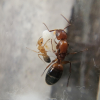- Formiculture.com
- Forums
- Gallery
- Members
- Member Map
- Chat

Can Camponotus discolor have multiple queens?
Started By
AntsTopia
, Mar 28 2024 3:21 PM
10 replies to this topic
#1
 Offline
-
Posted March 28 2024 - 3:21 PM
Offline
-
Posted March 28 2024 - 3:21 PM
Hi everyone! My friend in Florida caught two discolor queens a while ago and didn't know if he should put them together. He did not do so, but I'm still wondering what would've happened to this day. This question generally interests me because I have had colonies of C. Discolor myself since I lived in Florida. Does anyone know about this?
Is it just me that likes the look of ant brood? It just reminds of you how well an ant colony is doing.
#2
 Offline
-
Posted March 28 2024 - 3:30 PM
Offline
-
Posted March 28 2024 - 3:30 PM
It seems very unlikely as this isn't how wild colonies are found. And really one queen is enough. Have you seen all these eggs I'm dealing with?
Sometimes newly mated queen alates will tolerate each other when their nests are small, but one of them either leaves or the workers get rid of one of the queens. That's how it works with Camponotus nicobarensis. Camponotus isn't a genus well known for polygyny even if they love polydomy.
- AntsTopia and Artisan_Ants like this
Starting this July I'm posting videos of my ants every week on youTube.
I like to make relaxing videos that capture the joy of watching ants.
If that sounds like your kind of thing... follow me >here<.
#3
 Offline
-
Posted March 28 2024 - 3:35 PM
Offline
-
Posted March 28 2024 - 3:35 PM
It seems very unlikely as this isn't how wild colonies are found. And really one queen is enough. Have you seen all these eggs I'm dealing with?
Sometimes newly mated queen alates will tolerate each other when their nests are small, but one of them either leaves or the workers get rid of one of the queens. That's how it works with Camponotus nicobarensis. Camponotus isn't a genus well known for polygyny even if they love polydomy.
Yeah they do lay a lot of eggs that's for sure. It would be cool if they could have another queen though. I think that C. Vicinus is the only polgynus one, right?
Is it just me that likes the look of ant brood? It just reminds of you how well an ant colony is doing.
#4
 Offline
-
Posted March 28 2024 - 4:02 PM
Offline
-
Posted March 28 2024 - 4:02 PM
I know C.vicinus is poly I had a colony with 6 queens and they tolerated each other, even after the several Thousand mark.
- futurebird and AntsTopia like this
Currently keeping: 2 C.vicinus colonies.2 C.sansabeanus. 1 C.leavissimus. 2 C.Ca02. 1 V.pergandei. 4 T.immigrans.1 F.pacifica. 1 C.hyatti
1 M.ergatognya
Trying to get my hands on :C.modoc,A.vercicolor, and Any Honeypots
#5
 Offline
-
Posted March 28 2024 - 4:19 PM
Offline
-
Posted March 28 2024 - 4:19 PM
I know C.vicinus is poly I had a colony with 6 queens and they tolerated each other, even after the several Thousand mark.
wow
Is it just me that likes the look of ant brood? It just reminds of you how well an ant colony is doing.
#6
 Offline
-
Posted March 28 2024 - 4:24 PM
Offline
-
Posted March 28 2024 - 4:24 PM
C. planatus, if I remember correctly, are polygynous. You can add queens AND workers to established colonies. (Correct me if I'm wrong, but I'm like 99.999% sure that somebody once told me that). I don't remember if any other Florida Camponotus species are polygynous.
I do know there's a Florida keeper who successfully managed to keep a polygynous C. floridanus colony, which goes against what we thought could happen. But it worked somehow.
I do know there's a Florida keeper who successfully managed to keep a polygynous C. floridanus colony, which goes against what we thought could happen. But it worked somehow.
Edited by Flu1d, March 28 2024 - 4:25 PM.
- GOCAMPONOTUS likes this
#7
 Offline
-
Posted March 28 2024 - 4:28 PM
Offline
-
Posted March 28 2024 - 4:28 PM
Online I read most Camponotus are polygynous but they just don't tolerate each other.
Edited by GOCAMPONOTUS, March 28 2024 - 4:29 PM.
Currently keeping: 2 C.vicinus colonies.2 C.sansabeanus. 1 C.leavissimus. 2 C.Ca02. 1 V.pergandei. 4 T.immigrans.1 F.pacifica. 1 C.hyatti
1 M.ergatognya
Trying to get my hands on :C.modoc,A.vercicolor, and Any Honeypots
#8
 Offline
-
Posted March 28 2024 - 4:31 PM
Offline
-
Posted March 28 2024 - 4:31 PM
I believe you are right.C. planatus, if I remember correctly, are polygynous. You can add queens AND workers to established colonies. (Correct me if I'm wrong, but I'm like 99.999% sure that somebody once told me that). I don't remember if any other Florida Camponotus species are polygynous.
I do know there's a Florida keeper who successfully managed to keep a polygynous C. floridanus colony, which goes against what we thought could happen. But it worked somehow.
Currently keeping: 2 C.vicinus colonies.2 C.sansabeanus. 1 C.leavissimus. 2 C.Ca02. 1 V.pergandei. 4 T.immigrans.1 F.pacifica. 1 C.hyatti
1 M.ergatognya
Trying to get my hands on :C.modoc,A.vercicolor, and Any Honeypots
#9
 Offline
-
Posted April 2 2024 - 12:07 AM
Offline
-
Posted April 2 2024 - 12:07 AM
C. planatus, if I remember correctly, are polygynous. You can add queens AND workers to established colonies. (Correct me if I'm wrong, but I'm like 99.999% sure that somebody once told me that). I don't remember if any other Florida Camponotus species are polygynous.
I do know there's a Florida keeper who successfully managed to keep a polygynous C. floridanus colony, which goes against what we thought could happen. But it worked somehow.
Oh wow! I forgot anything besides C. floridanus lived here, haha. I never really recognized C. planatus are Camponotus due to their size, and I’d usually just think they are some sort of Formica without walking over to actually look. I feel very silly.
Edited by The_Gaming-gate, April 2 2024 - 12:08 AM.
Ants are small creatures... but together... they can rule the world.
#10
 Offline
-
Posted April 2 2024 - 11:26 AM
Offline
-
Posted April 2 2024 - 11:26 AM
Oh wow! I forgot anything besides C. floridanus lived here, haha. I never really recognized C. planatus are Camponotus due to their size, and I’d usually just think they are some sort of Formica without walking over to actually look. I feel very silly.C. planatus, if I remember correctly, are polygynous. You can add queens AND workers to established colonies. (Correct me if I'm wrong, but I'm like 99.999% sure that somebody once told me that). I don't remember if any other Florida Camponotus species are polygynous.
I do know there's a Florida keeper who successfully managed to keep a polygynous C. floridanus colony, which goes against what we thought could happen. But it worked somehow.
It's not silly, brother. They do look different from your typical Camponotus species here in Florida, so it's understandable! My goal is to one day get a C. planatus colony, but I'm in no rush. There are a lot of species I wanna keep so I'm just going with the flow.
#11
 Offline
-
Posted April 3 2024 - 10:42 AM
Offline
-
Posted April 3 2024 - 10:42 AM
It's not silly, brother. They do look different from your typical Camponotus species here in Florida, so it's understandable! My goal is to one day get a C. planatus colony, but I'm in no rush. There are a lot of species I wanna keep so I'm just going with the flow.Oh wow! I forgot anything besides C. floridanus lived here, haha. I never really recognized C. planatus are Camponotus due to their size, and I’d usually just think they are some sort of Formica without walking over to actually look. I feel very silly.C. planatus, if I remember correctly, are polygynous. You can add queens AND workers to established colonies. (Correct me if I'm wrong, but I'm like 99.999% sure that somebody once told me that). I don't remember if any other Florida Camponotus species are polygynous.
I do know there's a Florida keeper who successfully managed to keep a polygynous C. floridanus colony, which goes against what we thought could happen. But it worked somehow.
Agreed! I looked around today and found some C. planatus foragers! I hope I can catch a queen, but if not I’ll settle for C. floridanus. (They are pretty much a bigger planatus.)
Ants are small creatures... but together... they can rule the world.
0 user(s) are reading this topic
0 members, 0 guests, 0 anonymous users
















